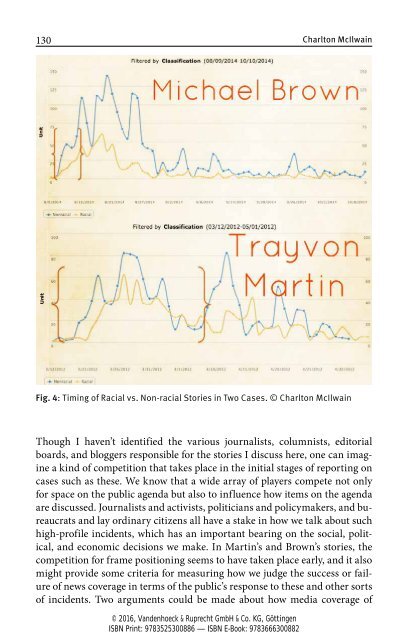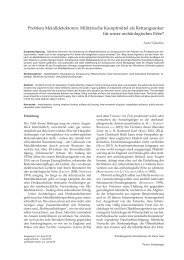- Page 1 and 2:
Georg Ruhrmann / Yasemin Shooman /
- Page 3 and 4:
Schriften des Jüdischen Museums Be
- Page 5 and 6:
Mit 21 Abbildungen Aus dem Deutsche
- Page 7 and 8:
6 Inhalt Evelyn Alsultany Arabs and
- Page 9 and 10:
© 2016, Vandenhoeck & Ruprecht Gmb
- Page 11 and 12:
10 Georg Ruhrmann, Yasemin Shooman,
- Page 13 and 14:
12 Georg Ruhrmann, Yasemin Shooman,
- Page 15 and 16:
14 Georg Ruhrmann, Yasemin Shooman,
- Page 17 and 18:
16 Georg Ruhrmann, Yasemin Shooman,
- Page 19 and 20:
© 2016, Vandenhoeck & Ruprecht Gmb
- Page 21 and 22:
© 2016, Vandenhoeck & Ruprecht Gmb
- Page 23 and 24:
22 Augie Fleras people, (c) stereot
- Page 25 and 26:
24 Augie Fleras representations of
- Page 27 and 28:
26 Augie Fleras caricatures of the
- Page 29 and 30:
28 Augie Fleras the media picture a
- Page 31 and 32:
30 Augie Fleras perpetuates a pro-w
- Page 33 and 34:
32 Augie Fleras tolerance and unive
- Page 35 and 36:
34 Augie Fleras communication. Rath
- Page 37 and 38:
36 Augie Fleras Fleras, Augie. Immi
- Page 39 and 40:
38 Augie Fleras Abstract Ein Großt
- Page 41 and 42:
40 Anamik Saha Part 1. Approaching
- Page 43 and 44:
42 Anamik Saha Part 2. Producing th
- Page 45 and 46:
44 Anamik Saha and maligned. Book c
- Page 47 and 48:
46 Anamik Saha he has commissioned:
- Page 49 and 50:
48 Anamik Saha to focus as much on
- Page 51 and 52:
Sally Lehrman Creating an Inclusive
- Page 53 and 54:
52 Sally Lehrman Media Production S
- Page 55 and 56:
54 Sally Lehrman Editors Census. A
- Page 57 and 58:
56 Sally Lehrman groups speak for t
- Page 59 and 60:
58 Sally Lehrman Economic & Social
- Page 61 and 62:
60 Sally Lehrman to be provided wit
- Page 63 and 64:
62 Sally Lehrman stereotypes.38 Jou
- Page 65 and 66:
64 Sally Lehrman this complaint by
- Page 67 and 68:
66 Sally Lehrman Silber, Jeffrey H.
- Page 69 and 70:
Christel Gärtner Religion and the
- Page 71 and 72:
70 Christel Gärtner part in transf
- Page 73 and 74:
72 Christel Gärtner due partly to
- Page 75 and 76:
74 Christel Gärtner And as a resul
- Page 77 and 78:
76 Christel Gärtner 3.2 Religion a
- Page 79 and 80: 78 Christel Gärtner sions in every
- Page 81 and 82: 80 Christel Gärtner Halm, Dirk.
- Page 83 and 84: © 2016, Vandenhoeck & Ruprecht Gmb
- Page 85 and 86: © 2016, Vandenhoeck & Ruprecht Gmb
- Page 87 and 88: 86 Daniel Wildmann German televisio
- Page 89 and 90: 88 Daniel Wildmann as a somatic phe
- Page 91 and 92: 90 Daniel Wildmann It is finally di
- Page 93 and 94: 92 Daniel Wildmann These networks b
- Page 95 and 96: 94 Daniel Wildmann How does this ep
- Page 97 and 98: 96 Daniel Wildmann the viewer’s p
- Page 99 and 100: 98 Daniel Wildmann friendship, Jews
- Page 101 and 102: 100 Daniel Wildmann and sidelocks,
- Page 103 and 104: 102 Daniel Wildmann Lezzi, Eva. “
- Page 105 and 106: Evelyn Alsultany Arabs and Muslims
- Page 107 and 108: 106 Evelyn Alsultany white man to s
- Page 109 and 110: 108 Evelyn Alsultany embargo (1973)
- Page 111 and 112: 110 Evelyn Alsultany thousand civil
- Page 113 and 114: 112 Evelyn Alsultany representation
- Page 115 and 116: 114 Evelyn Alsultany attack. In the
- Page 117 and 118: 116 Evelyn Alsultany References Pri
- Page 119 and 120: Charlton McIlwain Criminal Blacknes
- Page 121 and 122: 120 Charlton McIlwain month later,
- Page 123 and 124: 122 Charlton McIlwain Still Somethi
- Page 125 and 126: 124 Charlton McIlwain longer (as me
- Page 127 and 128: 126 Charlton McIlwain Fig. 2: Word-
- Page 129: 128 Charlton McIlwain But why is ra
- Page 133 and 134: 132 Charlton McIlwain Favorable Unf
- Page 135 and 136: 134 Charlton McIlwain Bibliography
- Page 137 and 138: Yasemin Shooman Between Everyday Ra
- Page 139 and 140: 138 Yasemin Shooman Islamophobia as
- Page 141 and 142: 140 Yasemin Shooman journalist-acti
- Page 143 and 144: 142 Yasemin Shooman An Ideologicall
- Page 145 and 146: 144 Yasemin Shooman from within to
- Page 147 and 148: 146 Yasemin Shooman and other white
- Page 149 and 150: 148 Yasemin Shooman East, the Jewis
- Page 151 and 152: 150 Yasemin Shooman of Turkish desc
- Page 153 and 154: 152 Yasemin Shooman References Prin
- Page 155 and 156: 154 Yasemin Shooman Politically Inc
- Page 157 and 158: © 2016, Vandenhoeck & Ruprecht Gmb
- Page 159 and 160: © 2016, Vandenhoeck & Ruprecht Gmb
- Page 161 and 162: 160 Peter Widmann The spotlight was
- Page 163 and 164: 162 Peter Widmann Europeans,” the
- Page 165 and 166: 164 Peter Widmann weaknesses of the
- Page 167 and 168: 166 Peter Widmann member of the fed
- Page 169 and 170: 168 Peter Widmann In addition, the
- Page 171 and 172: 170 Peter Widmann In addition, the
- Page 173 and 174: 172 Peter Widmann Europeans who spe
- Page 175 and 176: 174 Peter Widmann Kriesi, Hanspeter
- Page 177 and 178: 176 Peter Widmann behaupten. Die Fa
- Page 179 and 180: 178 Georg Ruhrmann minority groups,
- Page 181 and 182:
180 Georg Ruhrmann In times of inte
- Page 183 and 184:
182 Georg Ruhrmann kinds of key eve
- Page 185 and 186:
184 Georg Ruhrmann In sum, these fo
- Page 187 and 188:
186 Georg Ruhrmann xenophobic attac
- Page 189 and 190:
188 Georg Ruhrmann Scientific Evide
- Page 191 and 192:
190 Georg Ruhrmann 4. Summary and F
- Page 193 and 194:
192 Georg Ruhrmann Entscheidung, ed
- Page 195 and 196:
194 Georg Ruhrmann Abstract Migrati
- Page 197 and 198:
196 Tyler Reny, Sylvia Manzano Lati
- Page 199 and 200:
198 Tyler Reny, Sylvia Manzano Lati
- Page 201 and 202:
200 Tyler Reny, Sylvia Manzano “l
- Page 203 and 204:
202 Tyler Reny, Sylvia Manzano In s
- Page 205 and 206:
204 Tyler Reny, Sylvia Manzano Talk
- Page 207 and 208:
206 Tyler Reny, Sylvia Manzano fram
- Page 209 and 210:
208 Tyler Reny, Sylvia Manzano Tele
- Page 211 and 212:
210 Tyler Reny, Sylvia Manzano Refe
- Page 213 and 214:
212 Tyler Reny, Sylvia Manzano Tyle
- Page 215 and 216:
© 2016, Vandenhoeck & Ruprecht Gmb
- Page 217 and 218:
216 Shion Kumai In November 2014, j
- Page 219 and 220:
218 Shion Kumai In addition, with i
- Page 221 and 222:
220 Shion Kumai forms, such as the
- Page 223 and 224:
222 Shion Kumai “That’s a probl
- Page 225 and 226:
224 Shion Kumai through the mainstr
- Page 227 and 228:
Shion Kumai Wege zu mehr Vielfalt i
- Page 229 and 230:
228 Shion Kumai wenn wir versuchen,
- Page 231 and 232:
230 Shion Kumai Perspektive der Mas
- Page 233 and 234:
232 Shion Kumai Formate wie »The V
- Page 235 and 236:
234 Shion Kumai persönlicher Antri
- Page 237 and 238:
236 Shion Kumai Fazit Samantha Asum







